Recent Research
Chemical Dependency
Opioids
Illicit Drug Use
Marijuana
Alcohol
Tobacco
National Statistics on Chemical Dependency
- In 2011, approximately 22.5 million Americans 12+ used an illicit drug or abused medication in the past month
- The most commonly used drug is marijuana
- Most people use drugs for the first time as a teenager
- Chemical dependency is seeing an increase in people ages 50+
- In 2011, 30% of men 12+ and 14% of women reported binge drinking in the past month
- 9% of men and 2.6% of women reported heavy alcohol use: binge drinking on at least five separate days in the past month
- Teen binge drinking and driving under the influence are both down
SOURCE: The National Institute of Drug Abuse
Opioids
An opioid is any psychoactive chemical that resembles morphine or other opiates in its pharmacological effects. Opioids work by binding to opioid receptors, which are found principally in the central and peripheral nervous system and the gastrointestinal tract. The receptors in these organ systems mediate both the beneficial effects and the side effects of opioids. WIKIPEDIA
Nearly three out of four prescription drug overdoses are caused by prescription painkillers—also called opioid pain relievers. The unprecedented rise in overdose deaths in the US parallels a 300% increase since 1999 in the sale of these strong painkillers.4 These drugs were involved in 14,800 overdose deaths in 2008, more than cocaine and heroin combined.4
The misuse and abuse of prescription painkillers was responsible for more than 475,000 emergency department visits in 2009, a number that nearly doubled in just five years.6
More than 12 million people reported using prescription painkillers non-medically in 2010, that is, using them without a prescription or for the feeling they cause.
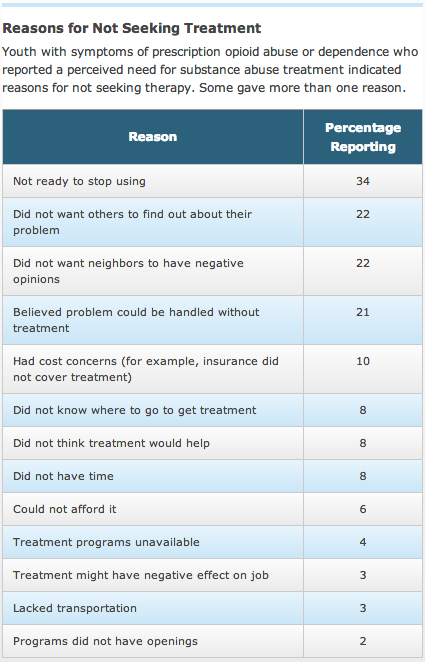
Source: National Institute on Drug Abuse
Opiate abuse and addiction is a dangerous, costly problem in the United States. The National Institute on Drug Abuse reports the following statistics regarding opiate abuse in the United States:
- Statistics show that Opiate abuse and Opiate addiction cost Americans over $484 billion annually. This amount includes healthcare costs and abuses of the healthcare system, lost wages, car accidents, crime, and criminal justice system costs.[1]
- Opiate use and addiction is linked to at least 50 percent of the major crimes in the United States; at least half of all suspects arrested for violent crimes (homicide, assault, etc.) were under the influence of opiates when arrested.[2]
- Reports indicate that nearly two-thirds of people in Opiate abuse treatment report were physically or sexually abused as children. [3]
- The 2002 Drug Abuse Warning Network (DAWN) reported that in 2002, heroin-related hospital Emergency Department episodes numbered 93,519.[4]
- According to the 2003 National Survey on Drug Use and Health, an estimated 3.7 million people had used heroin at some time in their lives, and over 119,000 of them reported using it within the month preceding the survey. An estimated 314,000 Americans used heroin in the past year. The group that represented the highest number of those users was 26 or older. Additionally, 57.4 percent of past year heroin users were classified with dependence on or abuse of heroin; an estimated 281,000 persons received treatment for heroin abuse.[5]
- In 2006, approximately 20.4 million Americans aged 12 or older were current (past month) illicit Opiate users. [6]
- According to the 2009 National Survey on Drug Use and Health (Substance Abuse and Mental Health Administration Web Site), 605,000 Americans age 12 and older had abused heroin at least once in the year prior to being surveyed.
- According to the Monitoring the Future survey, NIDA’s nationwide annual survey of drug use among the Nation’s 8th-, 10th-, and 12th-graders, heroin use remained stable from 2003 to 2004. Lifetime heroin use measured 1.6 percent among 8th-graders and 1.5 percent among 10th- and 12th-graders.
SOURCE: The National Institute of Drug Abuse
SOURCE: Caron Pennsylvania
Illicit Drug Use
Illicit drug use in America has been increasing. In 2011, an estimated 22.5 million Americans aged 12 or older—or 8.7 percent of the population—had used an illicit drug or abused a psychotherapeutic medication (such as a pain reliever, stimulant, or tranquilizer) in the past month. This is up from 8.3 percent in 2002. The increase mostly reflects a recent rise in the use of marijuana, the most commonly used illicit drug.
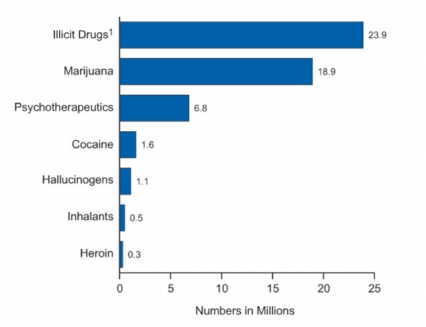
Source: National Institute on Drug Abuse
Marijuana
Marijuana use has increased since 2007. In 2011, there were 18.1 million current (past-month) users—about 7.0 percent of people aged 12 or older—up from 14.4 million (5.8 percent) in 2007.
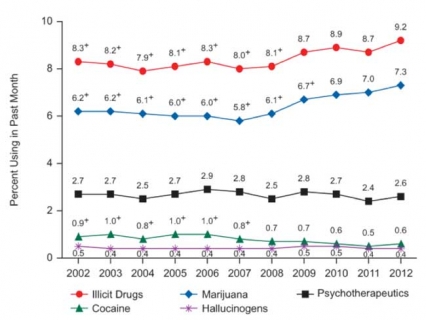
Source: National Institute on Drug Abuse
Use of most drugs other than marijuana has not changed appreciably over the past decade or has declined. In 2011, 6.1 million Americans aged 12 or older (or 2.4 percent) had used psychotherapeutic prescription drugs non medically (without a prescription or in a manner or for a purpose not prescribed) in the past month—a decrease from 2010. And 972,000 Americans (0.4 percent) had used hallucinogens (a category that includes Ecstasy and LSD) in the past month—a decline from 2010.
Cocaine use has gone down in the last few years; from 2006 to 2011, the number of current users aged 12 or older dropped from 2.4 million to 1.4 million. Methamphetamine use has also dropped, from 731,000 current users in 2006 to 439,000 in 2011.
Most people use drugs for the first time when they are teenagers.There were just over 3.0 million new users (initiates) of illicit drugs in 2011, or about 8,400 new users per day. Half (51 percent) were under 18.
More than half of new illicit drug users begin with marijuana. Next most common are prescription pain relievers, followed by inhalants (which is most common among younger teens).
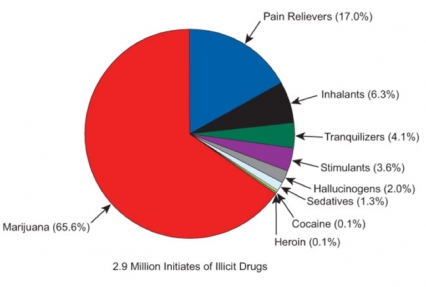
Source: National Institute on Drug Abuse
Drug use is highest among people in their late teens and twenties.In 2011, 23.8 percent of 18- to 20-year-olds reported using an illicit drug in the past month.
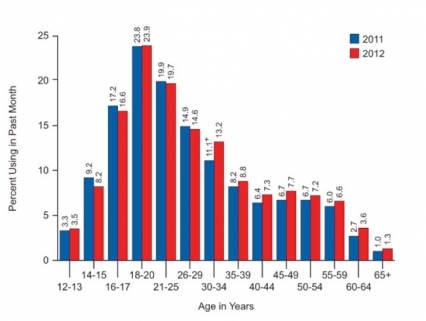
Source: National Institute on Drug Abuse
For more information on drug use among adolescents, see Drug Facts: High School and Youth Trends.
Drug use is increasing among people in their fifties. This is, at least in part, due to the aging of the baby boomers, whose rates of illicit drug use have historically been higher than those of previous cohorts.
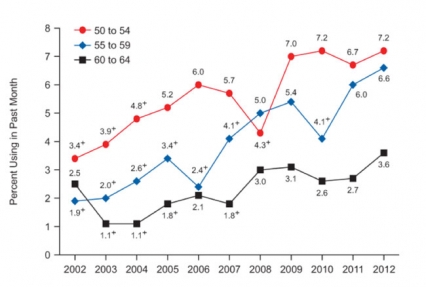
Source: National Institute on Drug Abuse
Alcohol
Drinking by underage persons (ages 12–20) has declined. Current alcohol use by this age group declined from 28.8 to 25.1 percent between 2002 and 2011, while binge drinking declined from 19.3 to 15.8 percent and the rate of heavy drinking went from 6.2 to 4.4 percent.
Binge and heavy drinking are more prevalent among men than among women. In 2011, 30.0 percent of men 12 and older and 13.9 percent of women reported binge drinking (five or more drinks on the same occasion) in the past month; and 9.1 percent of men and 2.6 percent of women reported heavy alcohol use (binge drinking on at least five separate days in the past month).
Driving under the influence of alcohol has also declined slightly. In 2011, an estimated 28.6 million people, or 11.1 percent of persons aged 12 or older, had driven under the influence of alcohol at least once in the past year, down from 14.2 percent in 2002. Although this decline is encouraging, any driving under the influence remains a cause for concern.
Tobacco
Fewer Americans are smoking. In 2011, an estimated 56.8 million Americans aged 12 or older, or 22 percent of the population, were current (past month) cigarette smokers. This reflects a continual but slow downward trend from 2002, when the rate was 26 percent.
Teen smoking is declining more rapidly. The rate of past-month cigarette use among 12- to 17-year-olds went from 13 percent in 2002 to 7.8 percent in 2011.
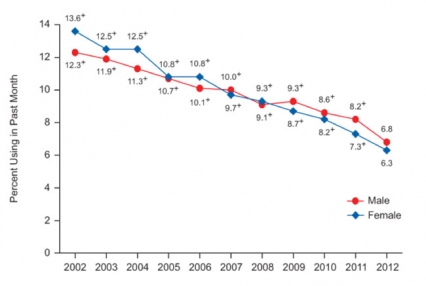
Source: National Institute on Drug Abuse
Substance Dependence/Abuse and Treatment
Rates of alcohol dependence/abuse declined from 2002 to 2011In 2011, 16.7 million Americans (6.5 percent of the population) were dependent on alcohol or had problems related to their use of alcohol (abuse). This is a decline from 18.1 million (or 7.7 percent) in 2002
After alcohol, marijuana has the highest rate of dependence or abuse among all drugs.In 2011, 4.2 million Americans met clinical criteria for dependence or abuse of marijuana in the past year—more than twice the number for dependence/abuse of prescription pain relievers (1.8 million) and four times the number for dependence/abuse of cocaine (821,000).
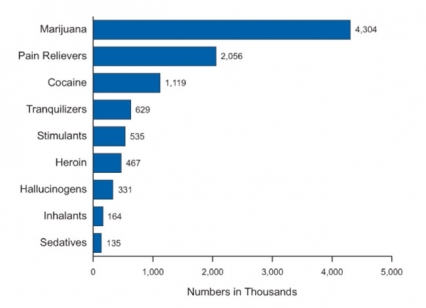
Source: National Institute on Drug Abuse
There continues to be a large “treatment gap” in this country. In 2011, an estimated 21.6 million Americans (8.4 percent) needed treatment for a problem related to drugs or alcohol, but only about 2.3 million people (less than 1 percent) received treatment at a specialty facility.
SOURCE: The National Institute of Drug Abuse
